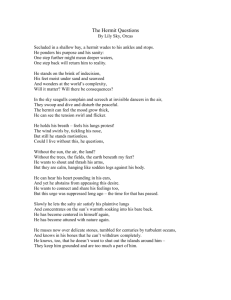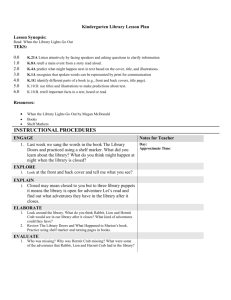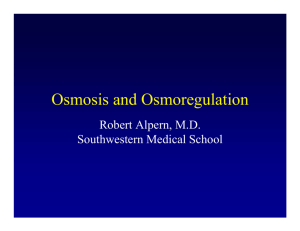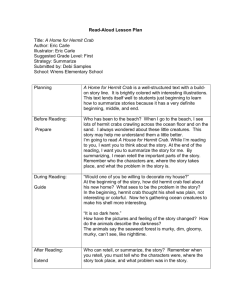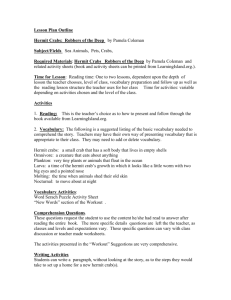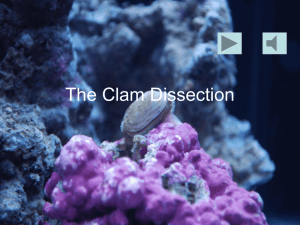Changes in hemolymph osmolality and gill Na+ K+
advertisement
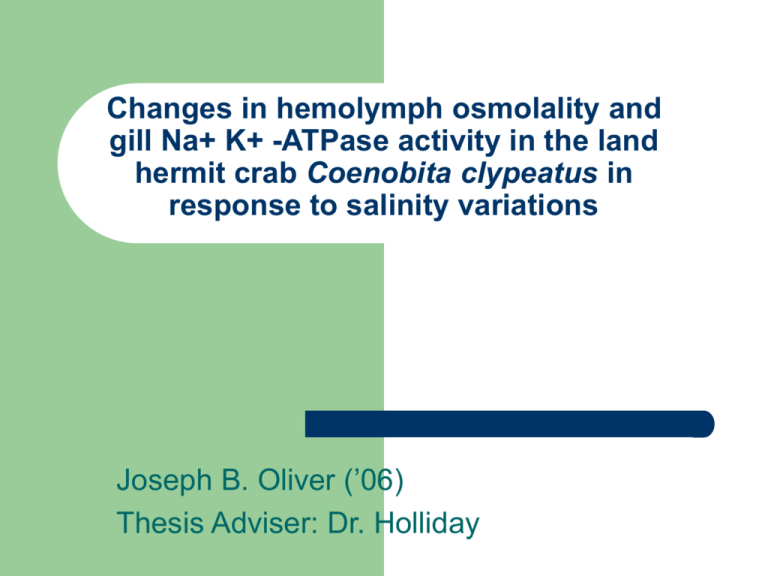
Changes in hemolymph osmolality and gill Na+ K+ -ATPase activity in the land hermit crab Coenobita clypeatus in response to salinity variations Joseph B. Oliver (’06) Thesis Adviser: Dr. Holliday Osmoregulation Osmoregulation is a form of homeostasis The methods of adjusting to the environment – – – Avoid Conform Compensate The classification of osmoregulation – – Stenohaline Euryhaline Na+, K+ -ATPase Mechanism Crustacean Gills – Osmoregulatory Organs: Model 1 Crustacean Gills – Osmoregulatory Organs: Model 2 Coenobita clypeatus http://foreverpurple.com/gallery/displ ayimage.php?album=24&pos=17 Develops in marine habitat and lives adult life on land Inhabits snail shell – vital for survival Found throughout Western Atlantic coastal areas Experimental Procedures Animal preparation – treatment conditions – – Open air Submerged Hemolymph sampling Gill Na+, K+ -ATPase assay Animal Care and Treatment Open Air: plastic shoe boxes (10.2 cm x 19.1 cm x 33 cm) and provided 2 water dishes and food, gravel on bottom Fully Submerged: cylindrical container (10.2 cm diameter, 7.6 cm height) with water replaced every 1-2 days, small air stone, and periodic feeding Hemolymph Sampling Wescor 5100C vapor pressure osmometer 8l of hemolymph assayed Measured in millimole solute / kg water milliosmolality (mOsm x kg-1) Na+, K+ -ATPase assay 4 parts to assay: – – – – Preparation of homogenates Homogenate ATPase assay Homogenate protein assay Calculations Enzyme Specific Activity (ESA) results: micromoles of phosphate liberated x mg-1 of protein x hour-1 by the sodium pump Hemolymph Osmolality in Open Air Conditions with Commercial Hermit Crab Food Hemolymph Osmolality (mOsm x kg-1) 1800 n=9 * 1600 1400 1200 n=9 * 1000 n=8 n=9 800 600 400 200 0 Control Freshwater only Saltwater only External Medium Hypersaline water only Gill Enzyme Specific Activity in Open Air Conditions with Commercial Hermit Crab Food 35 ESA (umol x mg-1 x hr-1) 30 n=9 n=8 n=9 25 ** n=9 * 20 15 10 5 0 Control Freshwater Only Saltwater Only External Medium Hypersaline Only Comparison of Hemolymph Osmolality of Open Air Crabs Fed Pellets and Fed Vegetation 2000 1800 n=8 * Hermit Crab Pellets Vegetation n=9 Hemolymph Osmolality (mOsm x kg-1) 1600 1400 1200 n=7 1000 n=9 n=7 * n=8 n=8 * n=9 * 800 600 400 200 0 Control Fres hwater Only Saltwater Only External Medium Hypers aline Only Comparison of Gill ESA of Open Air Crabs Fed Pellets and Fed Vegetation n=9 35 n=8 ESA (umol x mg-1 x hr-1) 30 n=7 * Hermit Crab Pellets n=7 * n=9 25 Vegetation n=8 n=9 n=8 20 * 15 10 5 0 Control Freshw ater Only Saltw ater Only External Medium Hypersaline Only Hemolymph Osmolality of the Fully Submerged Hermit Crabs Hemolymph Osmolality (mOsm x kg-1) 1400 n=6 * 1200 n=8 1000 n=8 800 * 600 400 200 0 400 mOsm 800 mOsm External Medium 1200 mOsm Gill ESA of Fully Submerged Hermit Crabs 35 n=8 -1 ESA (umol x mg x hr - 30 n=8 25 n=6 20 15 10 5 0 400 mOsm 800 mOsm External Medium 1200 mOsm Range Range Range Comments on Pattern Very high gill ESA when not osmotically stressed, little fluctuation under osmotic stress Seen also in beach hopper Megalorchestia californiana Advantage: Respond quickly to changes in available water by modulation of enzyme Interesting Tidbits Control animals closely resembled freshwater animals Seawater conditions are less osmotically stressful Not all salt comes from ion pumping by gills Diet may play an important role Conclusions on C. clypeatus Euryhaline crab species when submerged Strong hyperregulators in dilute conditions Well adapted to terrestrial lifestyle Osmoconformers in seawater and concentrated conditions Future Considerations Are changes in gill salt pumping due to modulation of existing enzyme or creation of new enzyme? What is the complete range of salinities C. clypeatus can survive in, and how long can they survive in these stressed conditions? THANK YOU FOR YOUR TIME AND ATTENTION At this time, I am able to field any questions
